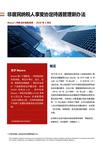
New Measures For Claiming Treaty Benefits
This new measure is one of the measures to optimize the taxation business environment and to “streamline administration, delegate powers and improve regulation and services”.
In detail
The PN 35 was effective from 1 January, 2020. It stipulates that non-resident taxpayers shall self-assess their eligibility to enjoy tax treaty benefits through the mechanism of “self- assessment of eligibility of claiming for treaty benefits and retaining documents for inspection”.
In respect of self-filing by non-resident taxpayers, e.g., claiming of treaty benefits under the exemption under the Permanent Establishment Article, the non-resident taxpayer shall self- assess its eligibility to enjoy the exemption under “no Permanent Establishment in China, and if the non-resident taxpayer qualifies, it should claim the exemption by submitting the “Reporting Form for Non-resident Taxpayers Claiming Tax Treaty Benefits” (the “Form”) in its tax filing. It must, however, collect and retain relevant supporting documents for post-filing inspection.
In respect of withholding by withholding agents, e.g., withholding tax on interest and dividends, the non-resident taxpayer shall self-assess its eligibility to enjoy tax treaty, and if it qualifies, it should provide the completed Form with the withholding agent. The non-resident taxpayer would still be required to collect and retain supporting documents for post-filing inspection.
The Issues In Respect of the Responsibilities
In the event of not meeting the relevant documentation requirement during post-filing inspection, the question becomes who should be accountable, the withholding agent or the non-resident taxpayers.
Withholding Agents’ Responsibility
Under the PN 35, the responsibility of the withholding agent is much reduced. Unlike under the PN 60, the withholding agent is no longer required to verify the non-resident recipient’s eligibility to enjoy treaty benefits based on the information provided. The withholding agent would only be required to check whether the Form provided by the non-resident recipient is complete.
Nevertheless, the withholding agent would continue to be responsible if it has not obtained the Form of if it has obtained the Form but fail to ensure that it is complete before the withholding tax is reduced or exempted, as the case maybe. In addition, the tax authority continues to be empowered to request for additional material from the withholding agent within a prescribed deadline, should the retained document be considered insufficient to prove the non-resident taxpayer’s eligibility to enjoy treaty benefits, or the non-resident taxpayer be suspected of evading taxes. In that case, the withholding agent may be held accountable for not fulfilling its obligation to withhold tax, thus subject to penalty under the Tax Collection Administration Law (“TCAL”) and Rules for the Implementation of the TCAL.
Non-resident Taxpayers’ Responsibility
Under the PN 35, the non-resident taxpayer is responsible for the authenticity, accuracy and legality of the Form and retained documents. The relevant materials supporting the claim would need to be retained for future inspection for a certain period as specified in TCA, generally for 10 years.
Article 9 of the PN 35 stipulates that when a non-resident taxpayer discovers that it had claimed treaty benefits which it was not entitled to, it shall take the initiative to report underpaid tax to the tax authority and settle the underpaid tax. Failure to do so would result in the tax authority demanding for payment of underpaid tax, as well as late payment surcharges. Nevertheless, in the situation that there is a withholding agent, and the withholding agent has provided the tax treaty benefit treatment, without receiving the Form or ensuring the Form is completed, the withholding agent would be responsible for late payment surcharge.
What Are the Required Materials to be retained?
The PN 35 lists out the relevant materials to be retained, which include the non-resident taxpayers’ relevant Tax Resident Certificate, the income-related contracts and agreements, the relevant resolutions of the board of directors and shareholders, payment vouchers and other ownership certifying materials and the relevant materials justifying the “beneficial ownership” of the relevant income such as interest, dividends and royalties.
In respect of the Form, the non-resident taxpayer would be required to sign and declare the following: (i) it was the tax resident of the other contracting jurisdiction; (ii) it has, through self- assessment, determined that it is in conformity with the conditions for claiming the tax treaty benefits and will bear the due legal responsibilities and (iii) it will collect and retain relevant documentation for subsequent post-filing inspection by the tax authority.
It should be pointed out that, unlike the previous PN 60, there is no 3 year exemption from submitting the supporting documents. Consequently, it may mean that some documents would need to be collected more frequently, e.g., Tax Resident Certificates. It remains to be seen as to how this would be enforced.
In respect of applying the PN 35 to individuals, it is important to point out that the relevant individuals would also need to fill in the Form, submit the same to the tax authority or to the withholding agent as the case maybe, in order to claim treaty benefit. For example, the Tax Resident Certificate would be required in order to claim any treaty benefit such as enjoying the 183 day exemption under Employment Income provision in the relevant tax treaty.
Mazars’ Comments
The new measure has simplified the paperwork for non-residents and facilitates the claiming of treaty benefits by non-resident taxpayers administratively. It is a welcome measure.
However, professional advice should be sought. For example, in the case of individuals claiming tax treaty benefits, the individuals may often be recognized as tax resident of both jurisdictions under the respective domestic laws, and often, one has to rely on the tie-breaker rules in the relevant tax treaty. The application of tie-breaker rules are rather complicated and assistance from professional experts should be sought in this regard.
The other issue relates to the determination of Beneficial Ownership. That determination and the related documentation are complex, and again professional advice should be sought in that regard.




